About our Chronology and Time Prophecies
“Without chronology,” says Dr. Hales, “history would lose its most valuable characters of truth and consistency, and scarcely rise above the level of romance” – Martin Anstey, The Romance of Bible Chronology (1913).
The Jewish nation had a Divine chronicler. “God, who at sundry times and in divers manners spake in time past unto the fathers by the prophets” (Hebrews 1:1). “Knowing this first, that no prophecy of the scripture is of any private interpretation. For the prophecy came not in old time by the will of man: but holy men of God spake as they were moved by the Holy Ghost” (2 Peter 1:20-21).
There have been several other chroniclers in history as well as those who have written about time prophecies and chronology. There are too many to list here, but we will list some of the students of influence who were the most direct links leading us to the ministry of Pastor Russell. We will try to trace in order the line of the history of our chronology and time prophecies that we use to our day.
HENRY FYNES CLINTON, ESQ. M.A. FASTI HELLENICI AND FASTI ROMANI (1824-1853)
Henry Fynes Clinton published a very large five-volume treatise, Fasti Hellenici (“Hellenic Almanac”), and Fasti Romani (“Roman Almanac”) in which he tried to compute the length of time from Adam until our day and also harmonize Scripture with the known archeology of his day. His work is a very extensive and scholastic work on this subject. He references all the ancient authors, explores the options and problems. He computes the date for Adam to be 4138 BC and he also has the birth of Abraham 10 years different than the Elliott/Bowen calculations. He has 2030 instead of 2020. Through projection we can see that he taught that the 6,000 years would end in 1862 AD.
“His reasoning is clear, his authorities are numerous, and his tone is moderate … His chronology contains perhaps fewer errors than that of any of his predecessors. He determines the Joshua-Judges ‘Chasm’ (20 years instead of 13) and the Samuel ‘Chasm’ (32 years instead of 20) by means of a subjective estimate, or conjecture, instead of by inference from the date contained in the Text, and for the Persian and Greek period from Cyrus to Christ, he adopts the figures of the Canon of Ptolemy instead of those of the prophet Daniel … He is to be blamed for his assertion that the figures given in the Books of Kings and Chronicles are sometimes ‘corrupt’ and to be rejected. But apart from these errors, which make his Era for the Creation BC 4138 … he is a most worthy and a most judicious guide” (Martin Anstey, The Romance of Bible Chronology, Marshall Brothers Ltd., London, p. 53, 1913).
Clinton deals entirely with history, the chronologies of major historical nations, and the Scriptural record. He does not specifically consider time prophecies.
EDWARD B. ELLIOTT (1793-1875) AND REV. C. BOWEN, HORAE APOCALYPTICAE, LONDON (1846)
Edward Bishop Elliott received his education at Trinity College in Cambridge in 1816. In commending his scholarship, the Adventist scholar Froom wrote: “Perhaps its most unique feature is the concluding sketch of the rise and spread of the Jesuit counter-systems of interpretation that had made such inroads upon Protestantism. Holding unswervingly to the Historical School of interpretation, Elliott gives the most complete exposure of these counter-interpretations to be found” (Leroy E. Froom, The Prophetic Faith of Our Fathers, Vol. 3, Review and Herald, p. 717, 1950).
The chronology of Henry Fynes Clinton’s work was adopted, refined, and published in Elliott’s 2,500-page, four-volume treatise Horae Apocalypticae (Hours, or Times, of the Apocalypse), in 1842. Throughout the space of several pages, Elliott explains what changes he made to Clinton’s work. To this chronology was appended a very long footnote beginning with the second edition of his work in 1846. It was in this edition that Elliott appended a chart of his “Scripture Chronology of the World” where he states that “on the fly-leaf is appended in illustration a Tabular Scheme of this Scripture Chronology, with the scriptural authorities in brief; drawn up by my friend and brother, the Rev. C. Bowen, Rector of St. Thomas, Winchester” ( Horae Apocalypticae, Second Edition, London, p. 259, 1846). It is this Scripture chronology, ending in 1872, which is the direct antecedent of our chronology.
However, this statement above presents us with two questions. (1) What Scripture chronology does Elliott refer to when he says “this Scripture Chronology?” (2) Did Bowen write the chronology list independent of Elliott, or did he only draw up a tabular scheme of Elliott’s chronology?
In answer to our first question we will refer directly to the first edition of Elliott’s treatise where the chronology presented in Clinton’s work was discussed extensively. Later a chart of this discussion was drawn up by the Rev. C. Bowen and appended to a footnote in the second edition of Horae in 1846 and the three succeeding editions following (the last in 1855).
“The … column was drawn up by Reverend C. Bowen, of England, for the Reverend E. B. Elliott, who gives it in his Horae Apocalypticae, as the chronology of Mr. Clinton, whence it was copied as such in the first edition. It varies, however from Mr. Clinton’s 10 years in the aggregate, and in a number of places in the detail …” (Daniel T. Taylor, The Voice of the Church, Rouse’s Point, N.Y., 1855, p. 319 of the electronic version published by Ages Library on the Reformation History, 2 CD-ROM). “This Scripture Chronology” which Elliott mentions in this footnote refers specifically to the several pages of discussion Elliott made on the chronology of Henry Fynes Clinton.
The second question can be answered by looking at the entire footnote where the chronology list appears. There is a reference in an earlier statement where Elliott discusses Henry Fynes Clinton’s chronology.
“According to the elaborate tables of one of the most judicious and learned of our modern chronologists, the late Mr. Fynes Clinton, the world’s 6,000 years would seem to be very near their ending” (Horae Apocalypticae, Second Edition, London, p. 254, 1846). “When [is] the termination of [the] sixth millenary? … Mr. Clinton, in his Essay on Hebrew Chronology, appended to the third volume of his late learned work entitled Fasti Hellenici, has greatly elucidated the subject” (Ibid., p. 254). “See my abstract of Mr. Clinton’s chronological argument and tables” (Horae Apocalypticae, Fifth Edition, London, p. 732, 1855). “… a difference … noted by me [Elliott] in the text …” (Horae Apocalypticae, Second Edition, London, p. 259, 1846).¹
From our examination of the first question we can now see that these statements, and others like it not cited here, suggest that the chronology was Elliott’s and he had his friend, Reverend Bowen, draw up the chart.
The answer to the second question is not as simple. It may be that the chronology was a cooperative effort between the two friends, Elliott and Bowen, but there is simply not enough information to determine if this is truth or conjecture. For though there may have been other influences on Elliott, or Clinton’s chronology, it is unfortunate that neither of them gave references as to how they developed their chronologies.
What we do know is that Elliott appears to have picked up John Aquilla Brown’s time prophetic views regarding the “Gentile Times” prophecy of “seven times” or 2,520 years. John Brown wrote a book in 1823 called The Even-Tide, which dated this prophecy from 604 BC to 1917 AD. Elliott lists this interpretation as well as the 606 BC to 1914 AD concept and others as several possibilities for fulfillment of this prophecy. Elliott did not see the 606 BC date as the fall of Jerusalem, but rather the first year when Nebuchadnezzar took prisoners from Israel to Babylon.2
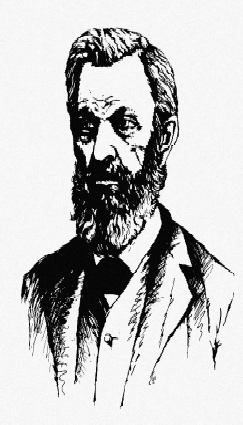 Br. Nelson Barbour
Br. Nelson Barbour
NELSON H. BARBOUR, THE MIDNIGHT CRY: EVIDENCES OF THE RETURN OF OUR LORD IN 1873, (1870)
After the disappointment of Miller, Nelson Barbour drifted off into unbelief and darkness for several years until he undertook a trip around the world. “To wile away the monotony of a long sea voyage, the English chaplain proposed a systematic reading of the prophecies” (Nelson H. Barbour, The Midnight Cry and Evidences for the Coming of the Lord in 1873, p. 32, 1871).
When they reached the 12th chapter of Daniel, Barbour noticed something that he had never noticed during his years as an Adventist. He questioned the explanation of the Abomination of Desolation ending in 1843. “Why did we begin the [1335] years thirty years before the abomination was set up? Here is our mistake, and it is one of thirty years. The days end in 1873, not 1843. All this came in a moment. From that hour … the whole truth of our position was made clear” (Ibid., pp. 32-33). In retrospect, it seems reasonable that “Bro. Miller and others assumed the long cherished view that 6,000 years would end with the Lord’s return. Understandably, they looked for a chronology which would make it so, and it is not surprising that Bros. Miller and Barbour both found systems which satisfied this view” (David Rice, Time and Prophecy, p. 78, 1995).
In London, Barbour discovered E.B. Elliott’s work, Horae Apocalypticae and saw that Elliott’s figure ended the 6,000 years in 1873. “When he looked at the figures, the shock, he says, almost took his breath away … Bro. Miller stated soon after 1843 had past, ‘that he could see no light this side of 1873 …’ ” (Ibid., pp. 33-34).³
While traveling back to America from London on the same ship, Barbour read Elliott’s treatise with great interest, comparing each line of reasoning with Scripture. At the same time he spoke with the ship’s chaplain and they made an attempt to end all of the time prophecies in the same year of 1873! Barbour continued his careful studying of Elliott’s writings after his return to America and wrote a book entitled The Midnight Cry and Evidence for the Coming of the Lord in 1873. He originally published this in 1870 and it went into a second edition by 1871. Jonas Wendell, an associate of Pastor Russell’s, as well as other Adventists, also focused on 1873. However, they thought they would witness the burning of the world and that the chronology of the history of the world ended at the beginning of 1873.
The year 1873 came and went and Jesus did not return. That same year Barbour started a monthly magazine, The Midnight Cry, that expounded his new chronological and time prophetic idea and new date of 1874. Two years later the title of the magazine was changed to Herald of the Morning, where he expounded the view that Jesus would return in 1874-75, adding the evidences of the Jubilees, and the Jewish-Gospel Age parallels. Barbour makes the suggestion that he found a new argument about the Jubilees coming out to 1874.
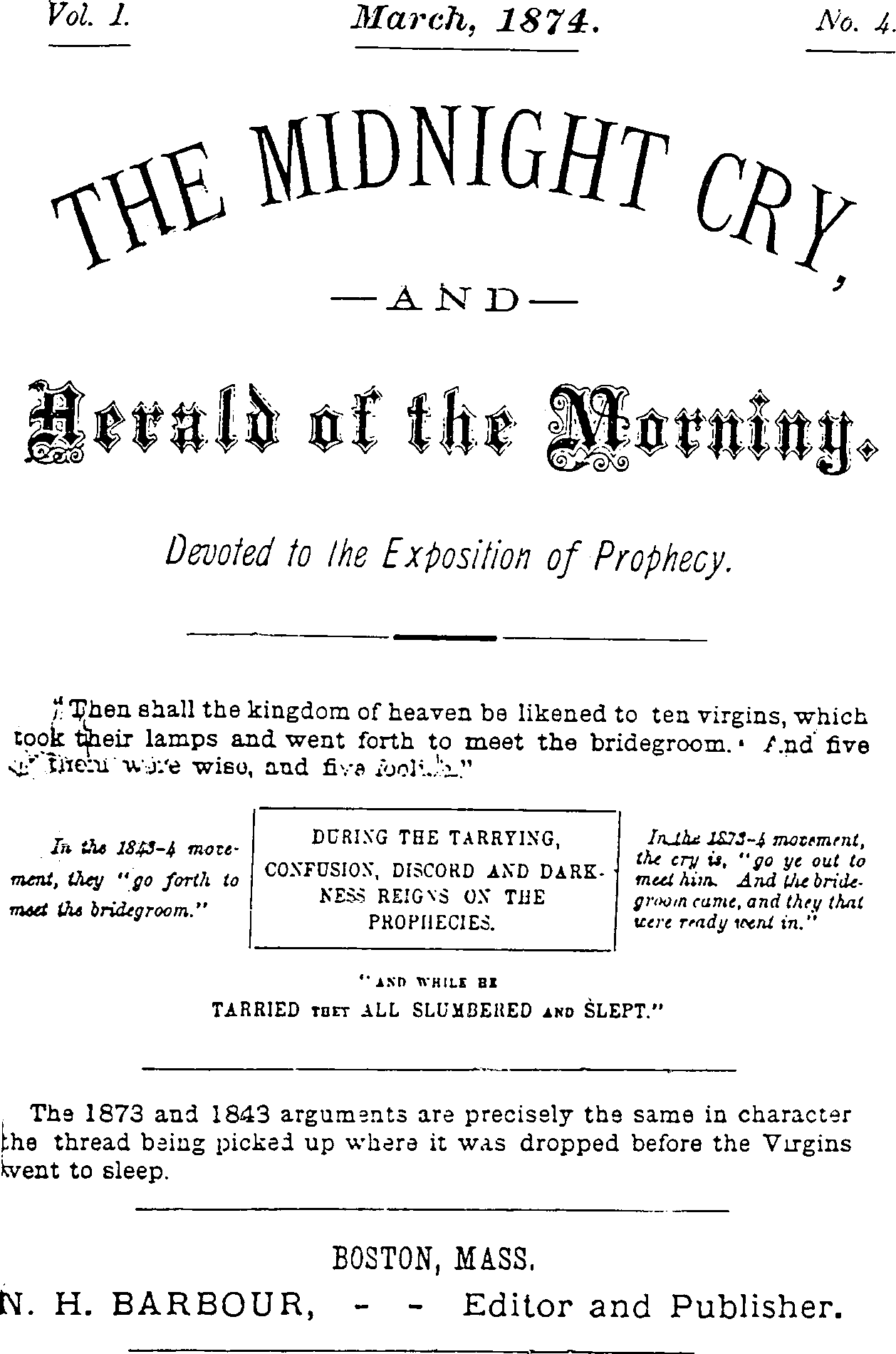
“I would call especial attention to the article on the Jubilees. It is a new argument, but one of the strongest ever presented on Time. When the 1335 ‘days’ of Daniel 12, expired, as in full years, they certainly have (and we are living in a little fraction of time ‘the prolonging of the vision,’ as shown in a former article), the force of that argument was spent; then it was that more light was required, and it came at the needed time. Suddenly, while walking in the street, the suggestion came, ‘The seventy years during which the land enjoyed her Sabbaths, is a key; turn that key. Divide the time during which jubilees were given, by fifty, and the time during which there were no jubilee years, by forty nine.’ It was evening, I hurried, I ran through the streets: I began to shout and praise God before reaching my room, satisfied it would come out 1874, but I wanted to see the figures. O! If it only does come out so, the last doubt will disappear; and I will give myself anew; soul body and spirit, to the work. When I put the figures down, just as they stand in the Bible chronology; just as they stand in the argument on ‘The two dispensations,’ which shows they are equal, that the time under the twelve Tribes was 1843 years; and that therefore, the time under the Gospel, will be 1843 years; and that they all center here, that they point to the ‘fourth day of the seventh month of 1874 longest period, my heart leaped with joy the Lord! The race is almost done a story soon to come” (N.H. Barbour, “Our Paper,” Herald of the Morning, March 1874, Vol. 1, No. 4, p. 2).
However, arriving at this date of Fall 1874 through a link to the Jubilee period was also in Horae Apocalypticae. “As to the Jubilaean chronology it seems possible that as seventy years marked the length of Israel’s waiting-time for the redemption from Babylon, and seventy weeks of years that of its further waiting for its primary redemption by Christ Jesus, so seventy Jubilees may define the mystical period of its whole existence as a people, from the Exodus to the epoch of both the natural and the spiritual Israel’s perfect redemption: a period which reckoned from the Exodus (each at fifty years) will end (on the basis still of Clinton’s Chronology) AD 1875. But there seems to me here far too much of the conjectural, to admit of our resting at all on the argument” (E. B. Elliott, Horae Apocalypticae, Second edition, 1846, p. 261).
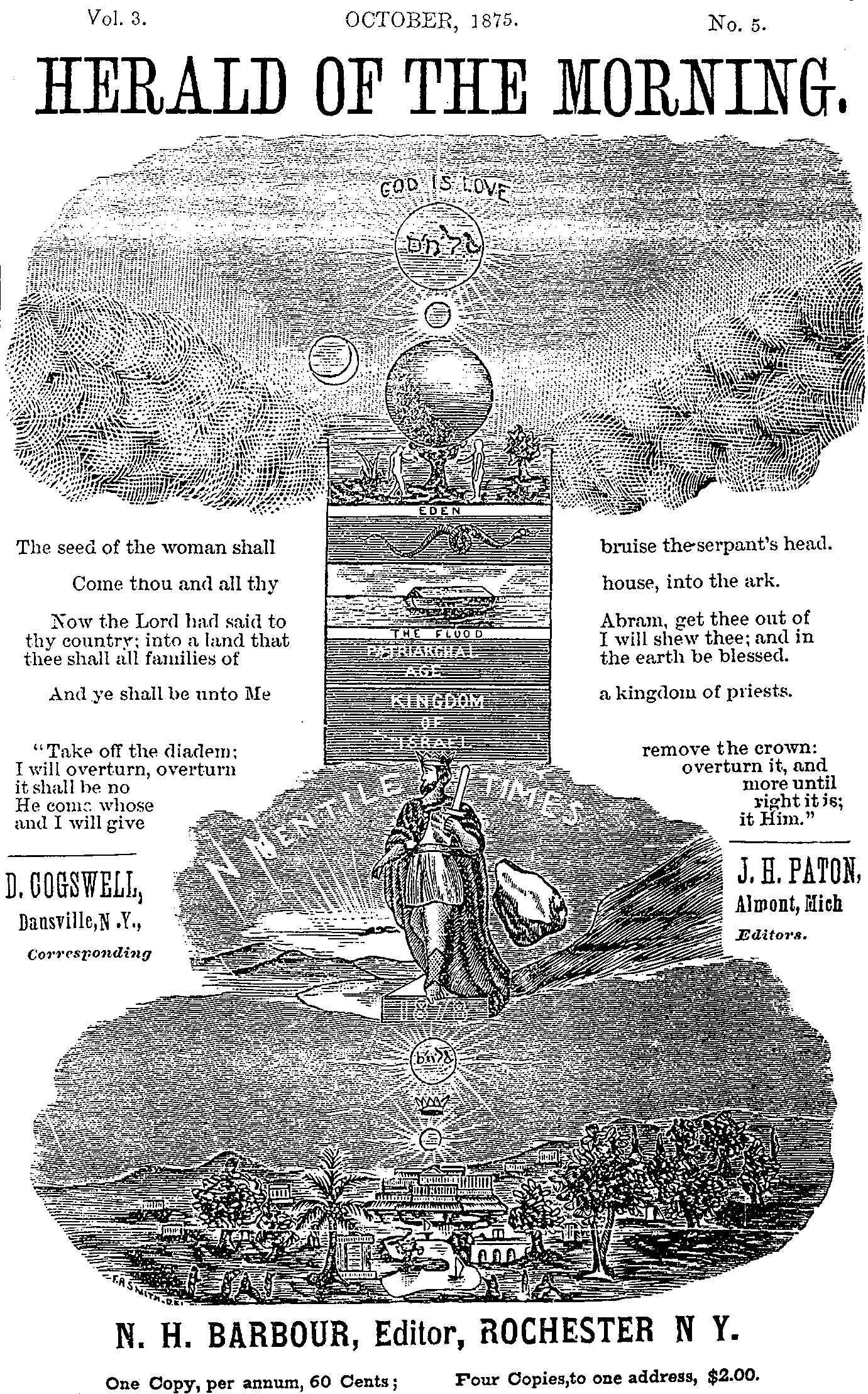
Barbour credited Horae for this discovery in the chronology, and several months later Barbour presented his thoughts on the “Gentile Times.” “There is a fixed period of Gentile rule, the four Gentile kingdoms, during which time Jerusalem is to be trodden down … the prophecies of Daniel, and the facts of history, prove that Jerusalem, ‘the sanctuary and the host,’ have been trodden under foot of the Gentiles for a longer period than the gospel has been given to them … there is a period of time called ‘seven times’ during which the Gentiles were to rule over literal Israel” (N.H. Barbour, “The Times of the Gentiles,” Herald of the Morning, October 1875, Volume 3, No. 5, p. 74).
This calculation is also found in Elliott’s work. “Of course if calculated from Nebuchadnezzar’s own accession and invasion of Judah, BC 606, the end is much later, being AD 1914; just one half century, or jubilean period, from our probable date of the opening of the Millennium” (E. B. Elliott, Horae Apocalypticae, Second edition, 1846, p. 261).
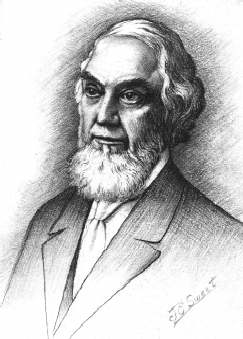
Pastor Charles Taze Russell
PASTOR CHARLES TAZE RUSSELL
It was about January 1876 (see R5909) when a young Charles Taze Russell found a copy of Barbour’s Herald of the Morning. His attention was immediately attracted to the time prophecies of Barbour and Patton as well as other Scriptural understandings.
“The Editor was beginning to get his eyes open on the subjects that for some years had so greatly rejoiced our hearts here in Allegheny – that the object of our Lord’s return is not to destroy, but to bless all the families of the earth, and that his coming would be thief-like, and not in flesh, but as a spirit-being, invisible to men; and that the gathering of his Church and the separation of the ‘wheat’ from the ‘tares’ would progress in the end of this age without the world’s being aware of it” (C.T.Russell, Zion’s Watch Tower, July 15, 1906, R3822).
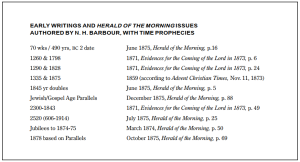
Although Pastor Russell was not exclusively under the aura of Barbour for the chronology studies, he did accept without modification nearly every one of Barbour’s time prophetic interpretations in the summer of 1876. The exception comes for the 1260 “days” that Pastor Russell later changed from 1798 to 1799. Barbour, in turn, had accepted a number of chronology links in general circulation amongst Adventists. Each of the Time prophecies taught in the second and third volumes of the Studies in the Scriptures appeared in Nelson Barbour’s writings before meeting Pastor Russell. (See chart above.)
Later, Pastor Russell wrote of his first meeting with Barbour in 1876: “But there were no books or other publications setting forth the time-prophecies as then understood, so I paid Mr. Barbour’s expenses to come to see me at Philadelphia (where I had business engagements during the summer of 1876), to show me fully and Scripturally, if he could, that the prophecies indicated 1874 as the date at which the Lord’s presence and ‘the harvest’ began. He came, and the evidences satisfied me. Being a person of positive convictions and fully consecrated to the Lord, I at once saw that the special times in which we live have an important bearing upon our duty and work as Christ’s disciples; that, being in the time of harvest, the harvest-work should be done; and that Present Truth was the sickle by which the Lord would have us do a gathering and reaping work everywhere among his children.”
“I inquired of Mr. Barbour as to what was being done by him and by the Herald. He replied that nothing was being done; that the readers of the Herald, being disappointed Adventists, had nearly all lost interest and stopped their subscriptions; and that thus, with money exhausted, the Herald might be said to be practically suspended. I told him that instead of feeling discouraged and giving up the work since his newly found light on restitution (for when we first met, he had much to learn from me on the fullness of restitution based upon the sufficiency of the ransom given for all, as I had much to learn from him concerning time), he should rather feel that now he had some good tidings to preach, such as he never had before, and that his zeal should be correspondingly increased. At the same time, the knowledge of the fact that we were already in the harvest period gave to me an impetus to spread the Truth such as I never had before. I therefore at once resolved upon a vigorous campaign for the Truth.”
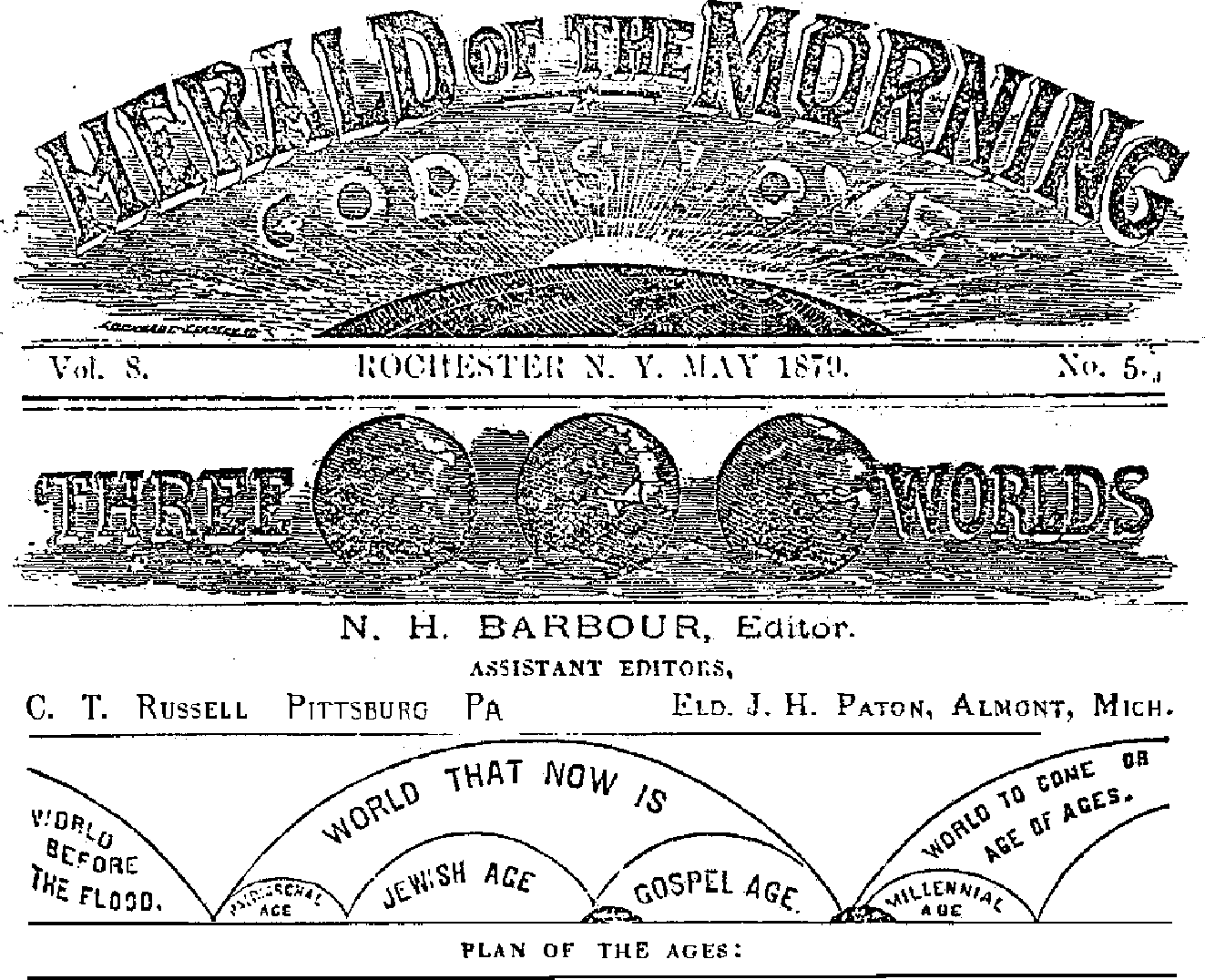

“… While it (The Three Worlds) was not the first book to teach a measure of restitution, nor the first to treat upon time-prophecy, it was, we believe, the first to combine the idea of restitution with time-prophecy” (C.T. Russell, Zion’s Watch Tower, July 15, 1906, R3822).
After The Three Worlds (1877) was published in its entirety, Barbour restarted the Herald journal, now with J.H. Paton and Pastor Russell as co-editors. Nearly a year later Barbour wrote and published an article denying the substitutionary atonement of Christ (Herald of the Morning, August 1878). Pastor Russell wrote a response to Barbour’s article in the very next issue defending the ransom. Barbour countered this article, and soon letters focusing on the controversy circulated among the three editors. Pastor Russell’s 2½-page article was followed by Barbour’s 3½-page editor’s note again denying the doctrine. Pastor Russell then discussed the matter with Bro. John H. Paton requesting that “he also write an article for the Herald, which, in no uncertain tone, would give his witness for the precious blood of Christ” (C.T. Russell, Zion’s Watch Tower, May 1880, R1214). Paton’s article appeared in the October issue and another followed in December 1878.
After about a year of these debates, both public and private, Pastor Russell and J. H. Paton left to start Zion’s Watch Tower. Its mission would be to proclaim similar chronological and time prophetic concepts as Herald of the Morning, as well as defending the blood of Christ and the substitutionary atonement.
To conclude this brief survey of history of chronology, let us consider Pastor Russell’s observations and timely warnings on these tumultuous events as viewed from the seasoned perspective of 35 years:
“The general facts are much more valuable and important than merely the day or the year respecting these facts. ‘Let brotherly love continue!’ Suffer not any dispute over a day or a year to break the most precious bond of love which binds us to the Lord and to all who are truly his. Be specially careful on this point when the subject of discussion is one respecting which we have no positive knowledge. The rupture of fellowship may sometimes be necessary, when we ‘contend earnestly for the faith once delivered unto the saints’ – faith in the divine plan, in the Redeemer, in the efficacy of his death, etc. These matters are positively stated in the Bible – not left to deduction, as in the case of chronology and all matters based upon chronology” (C.T. Russell, Zion’s Watch Tower, November 15, 1913, R5348).
– Bro. Jeff Mezera
(1) Some other examples of Elliott’s thoughts and modifications of Clinton’s chronological work follow:
“The chronological question on which I have now to enter, becomes one of really important bearing on the point in hand …” (Ibid., p. 253-254).
“Thus there is nothing in the Jewish mundane chronology to affect the accuracy of Mr. Clinton’s … I cannot therefore but suspect that to constitute the interval this prophetic term of years may have been the abbreviator’s object …” (Ibid., p. 259).
“There remain but two small chasms in the Hebrew chronology to fill up, and one doubtful point to settle, arising from a difference between an Old Testament statement and one in the New Testament, in order to the completion of OUR chronological table” (Ibid., p. 257).
“Thus Mr. Clinton seems fairly to have estimated Joshua’s age …” (Ibid., p. 257).
“Mr. Clinton, not without reason, as it seems to me, prefers the latter” (Ibid., p. 258).
(2) “Nebuchadnezzar’s own accession and invasion of Judah, BC 606 …” Elliott, Horae Apocalypticae (Second Edition), p. 261. As was noted previously, it was not until the second edition of Horae that Elliott’s friend Bowen drew up Elliott’s chronology. However, it was not without modifications. Whether the modification was a misunderstanding of Elliott’s or Clinton’s concepts by Bowen, or some understanding of Bowen himself, is unknown.
The above statement agrees with the chronology of Clinton, which Elliott based his work upon. Clinton wrote, “We may place the expedition of Nebuchadnezzar towards the end of the 3rd and beginning of the 4th year, in the summer of BC 606” (Clinton, Henry Fynes, Fasti Helenici, p. 328, 1824). “The destruction of the temple is determined by concurrent sacred and profane testimony to July BC 587” (Ibid., p. 285).
In Elliott’s discussion of the chronology periods, he does not speak about the ending of the period of the Kings and the Desolation. The only thing that Elliott says is that 606 BC was the first accession year of Nebuchadnezzar and that 587 BC was Zedekiah’s captivity and destruction of the temple (see Horae Apocalypticae, Second Edition, p. 258). Bowen picks up all of Elliott’s changes to Clinton’s chronology, except he changed the understanding the 606 BC date from that of the other two men without any historical reference or documentation listed for us in Elliott’s work. It may be that Barbour looked at Bowen’s list without reference to the rest of Elliott’s statements on “this scripture chronology” and this would explain the difference.
(3) This statement of Barbour’s has not been validated in any way in any of the research we have done or by any of the Seventh Day Adventist scholars of Miller’s ministry.
